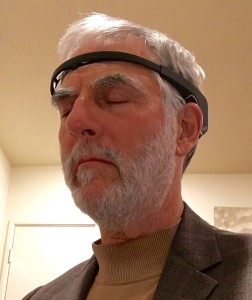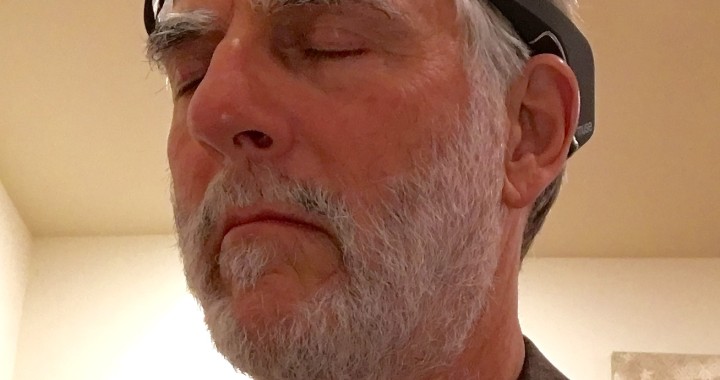In our office suite, a portion of which I call the EEGym®, we have some impressive neurofeedback systems (the more you know about the technologies of brainwave biofeedback, the more astonishing they are). In a future blog I should revisit that topic.
 I am often asked about home-use neurofeedback systems, and I regularly respond that for most people home systems are not really practical at this time. However, there are two app-based feedback systems which are reliable and very cost-effective that I recommend for almost everyone, the MUSE brainwave feedback system and Inner Balance (HeartMath) heart-rate variability feedback system. Each of these systems is actually a relaxation/mindfulness trainer in disguise. Both train meditative breathing as the therapeutic mechanism. And both–at this point in time–work with minimal technical fussing and are effective at what they set out to train. Beyond mindfulness and relaxation per se, they are likely to be helpful with such problem conditions as anxiety, insomnia, and hypertension.
I am often asked about home-use neurofeedback systems, and I regularly respond that for most people home systems are not really practical at this time. However, there are two app-based feedback systems which are reliable and very cost-effective that I recommend for almost everyone, the MUSE brainwave feedback system and Inner Balance (HeartMath) heart-rate variability feedback system. Each of these systems is actually a relaxation/mindfulness trainer in disguise. Both train meditative breathing as the therapeutic mechanism. And both–at this point in time–work with minimal technical fussing and are effective at what they set out to train. Beyond mindfulness and relaxation per se, they are likely to be helpful with such problem conditions as anxiety, insomnia, and hypertension.
I had been an early adopter of the MUSE system, but had abandoned it last November after being disillusioned by some serious connectivity problems that cropped up and have now been solved, and I am delighted to praise it once again (I bought my system from the company). The MUSE-Calm system consists of a headband ($299) http://muse calm, your smart-phone, and an app (free). It senses and records brainwave activity from the brain’s frontal and posterior temporal areas (forehead and behind-the ear sensors built into the headband). It is designed to register and also encourage the calm, meditative state that comes from regular deep and effortless breathing. It tracks your practice within each session and over time, letting you know when you are Active, Neutral, or Calm using intuitive sounds. If your mind drifts toward sleep, activating sounds nudge you back to task. At present you can choose to use sea-side or weather sounds; when you hold a meditative state for a number of seconds you are also rewarded with a gentle sound of bird calls. The system has been continuously improved with the ways it uses to keep you motivated.
I can see that I since August 2014 have had 412 sessions (of various lengths from 3 minutes to 20 minutes), accumulated 33,147 points, gotten 439 birds, and am ready for a “Level 7 Challenge” (get 2000 points in a single session). I know that last evening, as I began composing this blog post in my head, I did six 3-minute sessions in a row. Look at the trend of my ruminating mind reflected in percentages of calm I recorded: 39% at first, then 28%, 18%, 12% and then 14%; at last, I got my mind quieted down reflected by a 63% calm score. You can’t fool MUSE just by relaxing your muscles, the “ego” has to get out the way as well!
____________
The Inner Balance app from HeartMath, Inc is a simple, attractive and effective Heart Rate Variability trainer. App is free (presently only IOS, not Android), the ear-lobe monitor is $129. Heart Rate Variability (HRV) measures the relationship between heart rate, breathing, and the body’s self-regulating balancing systems. Based on complex signal engineering, HRV is a sophisticated development in non-brainwave based biofeedback, surpassing the earlier ways biofeedback was applied in relaxation training (i.e., hand-warming temperature feedback, GSR electrodermal feedback, and even pulse oximetry). HRV training is not about achieving a steady heart rate, but about a complex coordinated heart function that is associated with stress reduction. HeartMath Inc calls its HRV function, Coherence training. Once you have acquired the ear sensor, the inner Balance app has all you need for HRV training, a breathing pacer and built-in training coach, and it maintains your history. The settings can be customized for sounds, challenge level and various views.
HeartMath, Inc asserts that its form of Coherence training is more effective because drawing on states of positive heartfelt emotions. I could not find any hard evidence for that, but it seems reasonable to me that HRV helps shape and establish positive mental and self-regulatory states.
Through its research arm HeartMath has funded studies and reviews for decades. For example, a 2010 study demonstrated no significant difference between mindfulness meditation and progressive muscle relaxation techniques for training HRV. If you are interested in the theory of heart-centered HRV practice, you can find a fine comprehensive theoretical review by Rollin McCraty (it was recently published, but essentially is a reworking of a 2002 review) on their publicly-accessible HeartMath ResearchInstitute web site.
_____________
Putting aside theory of self-regulation and the struggle to understand HRV signal-processing engineering, you can get reliable and effective home training through your smartphone in stress control and meditation from both of the recommended devices, the MUSE-Calm headband and the Inner Balance HRV ear lobe sensor.

